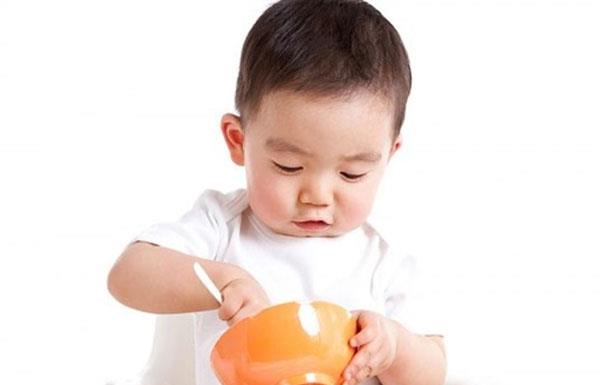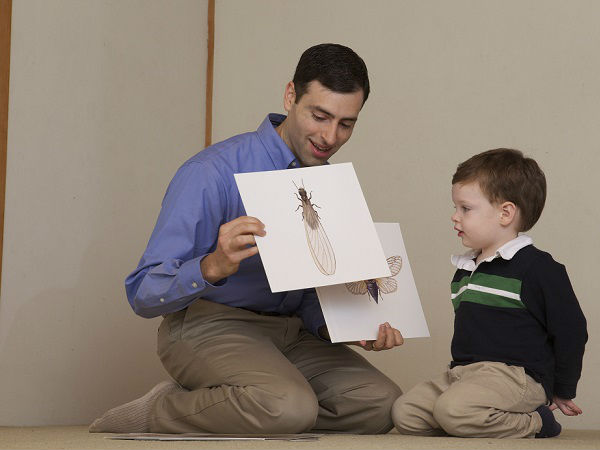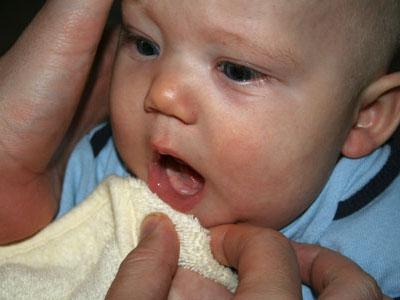Allowing your baby to scoop and pick himself up in each meal will form a habit that is beneficial to the health and behavior of young children. In addition, the earlier you help your child eat by himself, the less time and comfort the mother will lose, and less pressure from the child's eating and drinking.
Practicing baby self-feeding is a steady, long-term process that requires a mother's patience and proper method. Here are a few tips to make it easier for mothers to learn how to feed their babies themselves.
1 / The episode is sequential
At about 6 months of age, when the child was able to hold toys and entered a period of food miles , should the baby self pawn to eat, such as pieces of fruit, cake snack or vegetables boiled like carrots , green beans… This is an important process to educate your child to handle food on their own. When the baby is holding the food in his hand, he will explore it and put it in his mouth. Your baby will have to find a way to chew on them, that is a way for them to practice chewing.
8 - 9 months, the baby can sit steadily to practice eating by himself. Therefore, this is an ideal time when a mother can teach her baby to scoop with a spoon.
About 12 months or more, many babies can feed themselves with a spoon, although still fumbling about. Mother tries to maintain this habit, guide and adjust the way the baby can handle each day so that the baby can eat well at the age of 2 years.

Self-feeding is beneficial for both health and behavior
2 / Let your baby get used to the dining chair and eating utensils
Before teaching children to use spoon, mother and baby can use plastic spoon and spoon to play. Play pretend eating games with your baby as if you are taking food from a cup to your baby's mouth. Then, help your baby imitate these actions.
Have your baby sit and eat with his family in his own dining chair, put a little food such as vegetables and meat in the baby's bowl and let him scoop. Although the baby's emotional action cannot be mastered yet, it also helps the baby get used to holding dishes and learn to sit and eat like everyone else.
3 / Buy separate dishes and bowls
Shop for your baby a separate set of dishes. Choose a spoon with a short, curved handle that will make it easier for your baby to put it in his mouth. The spoon should be shallow and the width should be just right. With the cup, you should choose the type with a rim, light, not slippery to help your baby hold it more easily. You should also choose colorful, beautiful dishes that make your baby enjoy and should buy 2-3 sets of different sets to increase excitement for your baby.

What can you do to help your baby learn to walk? While many 9-month-olds have begun their first steps, most babies have to wait until 12 months to begin to walk, and wait until 14-15 months to walk. steady
4 / Create a fun and interesting environment
In training the habit of feeding babies by themselves, mothers need to create attractive environmental factors for children, create attractive foods for children to enjoy, possibly starting with touching easy-to-eat things with children.
Pay attention to the sitting position to eat, choose the right spoon, cup, table, chair, create love for children and a happy and open family atmosphere when children sit and eat.
5 / Psychology
Be patient, gentle, but determined, and understand the child's psychology . Praise your baby's effort to hold a spoon, every time she touches food into her mouth with less drops. Being praised and encouraged, the baby will be very excited and excited about eating by himself.
6 / Modeling and instructions for your baby
Before a child scooped food, parents and adults also used a spoon to scoop their food as a model, showing the child the joy of the person who scooped it and how to scoop it.
At the same time, instruct your baby to know how to sit, how to put a spoon in his mouth, chew carefully when eating, slowly and concentrate ... Mom can tell them simple and lively stories about movement. the harm of eating improperly such as easy tooth decay, stomach pain ... or if you eat too slowly, you will not have time to play, listen to your mother tell stories ...

Feeding your child to feed themselves is also a basic step for children to practice independence and self-care skills
7 / Persistent implementation
When teaching children to scoop food by themselves, you need to be patient because the child is not fluent right away. If you are impatient and feed your child again, it is difficult to practice feeding the child by himself. You should not be impatient, should not be afraid of getting dirty, need to persistently help and wait for your baby.
8 / Eye-catching food decoration
Baby food doesn't need much seasoning, fussy or elaborate. Just need the mother to decorate the eye-catching, increase the color and vividness of the food, the baby will love immediately.
9 / Let your baby take the initiative
Practicing self-feeding is a good habit that is more important than eating a lot or not. Give your child the opportunity to choose the right foods from the prepared menu. This is a way for children to feel respected and also a way for parents to know what their children like to eat and what they do not like to eat.
10 / There are rules and discipline
Be strict with your baby if he touches food and then throws the food or spoon. This will create a bad habit for your baby. Teach your baby the purpose of holding a spoon in the first place, so that in the future you don't have to run after fixing bad habits for your baby. If your baby is bored and mischievous, you should stop the "learning" of the baby here and start over at the next meal.

Teaching babies to care for others Unlike their physical development, the child's spiritual development and social capacity always need the close companionship of their parents. Children do not naturally care and share with others without going through a process of patient orientation and adjustment from parents. Job...
>>> See more discussions with related topics:
Practice feeding your child
Son to eat by himself















